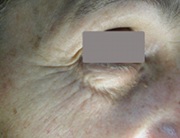According to Sederma, in vivo studies have revealed the positive effect of Matrixyl 3000 by measuring SLEB (subepidermal low echogenic band)

T28
density. In just one month an improvement corresponding to an age reversal of 1.8 years is visible, while photo-induced ageing is delayed by 5.5 years in two months.Meanwhile, analysis of the papillary dermis by confocal laser microscopy has shown that Matrixyl 3000 helps reduce fibre fragmentation and notably supports the reconstruction of the papillary dermal fibre network.

T56

